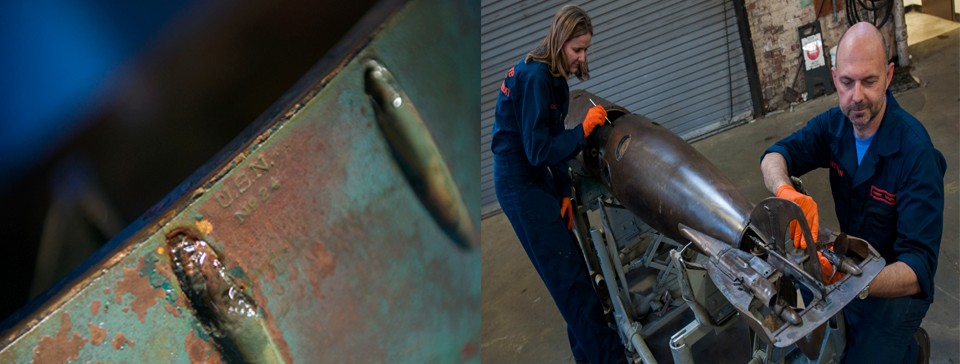
Howell Torpedo No.24
History
The Howell Mark I torpedo, developed between 1870 and 1889 by Lieutenant Commander John A. Howell, was the first self-propelled torpedo of American design. It was smaller, lighter, faster, longer-running, and carried more explosive material than competing models produced in Britain. While many contemporary torpedoes utilized internal compressed air engines, the Howell was powered by a 132-pound (60 kg) flywheel that drove the propellers. The flywheel, spun to 10,000 rpm by an onboard steam turbine from either the ship's deck or a submerged torpedo tube, acted as a means of propulsion and provided directional stability. The motion of the flywheel created a gyroscopic effect that helped the torpedo maintain a straight course throughout its run while producing very little wake with a maximum speed of 26 knots over 400 yards (366 m).
In 1888, the Navy ordered 50 Howell torpedoes, which were used on U.S. Navy battleships and torpedo boats for about 10 years. The Navy replaced it with a different torpedo model that did not require the cumbersome flywheel. Previous to the discovery of No. 24, only two Howell torpedoes were known to exist, located at the Naval Undersea Museum in Washington and the Naval War College Museum in Rhode Island.
Discovery
In March 2013, during a routine training exercise off the coast of San Diego, two dolphins in the Navy's Marine Mammal Program reported the presence of an unknown buried object. Navy divers investigated and recovered two sections of a torpedo. The third section, or "nose cone" that would have originally contained the warhead, was not found in the immediate area. Research indicated that it was a Howell torpedo, and closer inspection of the tail section revealed a stamped serial number: USN No. 24. The Underwater Archaeology Branch conducted extensive archival research, leading to the discovery of a 20 December 1899 entry in USS Iowa's deck log that stated, "Lost H. Mark I, No. 24 torpedo...". The battleship Iowa (BB-4) had anchored off the coast of San Diego to conduct target practice. A practice warhead was used in training exercises, fastened onto the torpedo with only four pins and a screw. The practice head may have become detached from the torpedo body, which could explain why it was never recovered.
Conservation
The torpedo was transported to NHHC's Underwater Archaeology and Conservation Laboratory in Washington, D.C., for stabilization and conservation treatment. Despite spending more than a century underwater, Howell torpedo No. 24 is in a relatively good state of preservation. It is a composite artifact made out of copper and iron alloys, steel, and rubber gaskets. Since each component has different properties and rates of degradation, they are treated according to their specific conservation needs.
The first step in the conservation of the Howell torpedo was desalination, removing the chloride salts that have permeated the artifact during its time submerged. The two sections were placed in circulated baths of de-ionized water and a sodium carbonate solution until all the chlorides were removed. The conservators then mechanically removed corrosion on the exterior and interior of the torpedo sections. Conservators partially disassembled the torpedo to access the interior of the middle body and carefully removed over 130 lbs. (59 kg) of sediment that had accumulated inside. To further clean the artifact, they immersed it in chemical baths and gave the metal components a corrosion inhibiting treatment.
A particularly challenging aspect of the project was the cleaning and treatment of the steel flywheel. The body was too physically distorted to allow for the removal of the flywheel, so conservators had to treat it in its original position. The substantial supports surrounding it further impede access to the area, so conservators used a custom-designed electrolysis unit to stabilize the flywheel.
In the end, conservation was successful and the Howell Torpedo is now on exhibit at the United States Naval Undersea Museum in Keyport, Washington.


